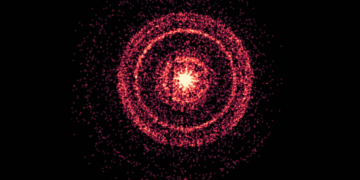The James Webb Space Telescope (JWST), NASA’s groundbreaking observatory, is revolutionizing our understanding of the cosmos. Recent observations by Webb have shed new light on GRB 221009A, the brightest gamma-ray burst ever recorded, offering a glimpse into the nature of the associated supernova and challenging our current models of these powerful stellar explosions.

GRB 221009A: A Beacon of Immense Energy
In October 2022, astronomers witnessed a celestial spectacle – GRB 221009A, a gamma-ray burst of extraordinary brilliance that shattered records. This colossal explosion, also known as Swift J1913.1+1946, blazed for a remarkable seven minutes, an unusually long duration for such an event. The immense energy released by GRB 221009A traveled nearly two billion light-years to reach Earth, significantly affecting our planet’s atmosphere. The sheer power and rarity (estimated to occur only once every 10,000 years) have earned GRB 221009A the unofficial title of “BOAT” (Brightest Of All Time).
Webb Confirms Supernova Link and Uncovers Surprises
Using Webb’s near-infrared spectrum analysis and imaging capabilities, astronomers were able to confirm a crucial link between GRB 221009A and a supernova – a powerful stellar explosion. This association aligns with existing astrophysical models, which propose a connection between long-duration gamma-ray bursts (LGRBs) and supernovae. However, the rarity of these events has prevented direct observation until now.
A Supernova with a Twist: Less Nickel, More Questions
A closer look at the supernova revealed an unexpected twist. Analysis by a team of American and Canadian researchers suggests that this supernova produced a surprisingly low amount of radioactive nickel compared to similar events. Typically, the amount of nickel produced significantly impacts the brightness and longevity of a supernova. This anomaly challenges our current understanding of the relationship between supernovae and LGRBs. Scientists are now re-evaluating the role of nickel in these events and exploring alternative factors that might influence the properties of the associated supernovae.
The Mystery of Missing R-Process Nucleosynthesis
Another surprise emerged from Webb’s observations. Despite the immense energies involved, the researchers found no significant evidence of r-process nucleosynthesis. This cosmic process is responsible for creating roughly half of the elements heavier than iron on the periodic table. The absence of this fundamental process within the GRB 221009A environment provides valuable clues about the conditions necessary for r-process nucleosynthesis to occur. These conditions may be even more extreme than previously thought, and astronomers are now looking for new signatures within LGRBs and their associated supernovae that might reveal the locations where these heavy elements are forged.
A Metal-Poor Galaxy: A Cradle of Superlative Explosions?
The galaxy hosting GRB 221009A harbors another peculiarity – it exhibits one of the lowest metallicities ever observed. “Metallicity” refers to the abundance of elements heavier than hydrogen and helium. A low metallicity indicates an extremely primitive environment, largely devoid of the heavier elements produced by previous generations of stars. This may play a crucial role in the formation of such powerful gamma-ray bursts. The team’s analysis suggests a recent episode of star formation within this galaxy, potentially hinting at a link between stellar creation and these colossal events. The metal-poor environment may influence the evolution of massive stars, making them more likely to undergo the dramatic core collapse that produces both a supernova and an LGRB.
Molecular Hydrogen: A Supporting Actor
Webb’s observations also revealed the presence of significant molecular hydrogen emissions associated with GRB 221009A. This detection points towards dense star-forming regions, lending credence to theories about the origin of massive stellar progenitors, the stars that give rise to LGRBs. These massive stars are born and die within these turbulent stellar nurseries, and the presence of molecular hydrogen is a key indicator of such environments. Without Webb’s exceptional sensitivity and spatial resolution, these crucial details would have remained hidden.
The Quest Continues: Unveiling the Secrets of R-Process Nucleosynthesis
The research team is optimistic that Webb’s capabilities will lead to the identification of additional sites of r-process nucleosynthesis. Future observations using late-time infrared spectroscopy have the potential to solidify their findings. They may also shed light on the specific conditions required for this process to occur. This groundbreaking study, published in Nature Astronomy under the title “JWST detection of a supernova associated with GR



















